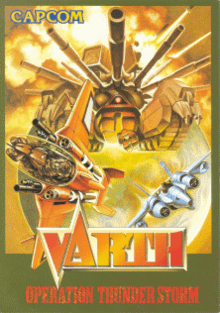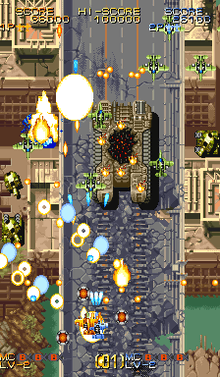Varth: Operation Thunderstorm
Varth: Operation Thunderstorm (バース オペレーション サンダー ストーム) (occasionally known simply as "Varth") is an arcade game in the vertical scrolling shooter genre, published by Capcom in 1992.[1] The game did not see a console port following its initial release, but 14 years later Digital Eclipse Software would port the game onto the PSP handheld (in the Capcom Classics Collection), and later onto the PlayStation 2 and Xbox.
| Varth: Operation Thunderstorm | |
|---|---|
 | |
| Developer(s) | Capcom |
| Publisher(s) | Capcom Romstar (US) |
| Composer(s) | Masaki Izutani Yoko Shimomura |
| Platform(s) | Arcade, PlayStation Portable, PlayStation 2, Xbox |
| Release | |
| Genre(s) | Vertical scrolling shooter |
| Mode(s) | Single player, 2 player Co-op |
| Cabinet | Upright |
| Arcade system | CPS-1 |
| Display | Raster standard resolution, vertical |
Plot
Varth follows the story of a disaster that befalls a human colony on a planet of the same name. The entire colony is run by a 7th generation supercomputer which controls the operations of all machinery on the planet. Unfortunately for the residents of Varth, Delta-7 has been possessed by the entity "DUO" (Dimension Unbody Offender), thought of as an evil spirit but actually a temporal-spatial consciousness which spontaneously arose within the supercomputer. DUO has come to the conclusion that human existence is inimical to the planet, and has therefore turned the planet's defenses against its own populace. Eighty percent of the planet is laid waste by the event, and this is only the beginning of DUO's cleansing scheme. The colonists' reliance on the supercomputer has caused them to lose the ability to take care of themselves, and thus have no means of fighting back. The only hope for the colony lies in the pilots of two planes equipped with 4th generation computers which DUO cannot control—they are controlled not by machinery, but by humans.
Gameplay

Varth's gameplay draws very heavily from 1942 and other games in Capcom's 194X series.[2] The goal is to destroy enemy units while avoiding being hit, and reach the end of the level, occasionally ending with a boss fight. There are 30 levels in the game. One hit from an enemy will cause the player to lose a plane. The biggest difference between Varth and most other games in the genre of its time is the inclusion of items called "Pods". When a player picks up a pod item, a pair of pods will follow the player and carry weaponry of their own to supplement their artillery. Additionally, pods can completely block most (but not all) forms of attacks from enemies, rendering the player almost invulnerable to attack from any direction in which the pods are situated. Players can choose from two formations for their pods - fixed or smart. In fixed mode, both pods remain directly in front of the player to render the planes invulnerable from the front, but leave them open on the sides and from behind. In the smart position the pods will remain separate from each other at a 180-degree angle, and move about according to the direction of incoming fire. If enemy fire manages to slip between the pods before they can react (potentially common in later levels as large numbers of enemies appear on screen), the player is left vulnerable and only has the option of moving in hopes of avoiding a hit.
Varth features three different weapons for the player - a laser (long rate of sustained fire but lowest horizontal range), a Machine gun (relatively powerful with a potential range as wide as the player's craft), and multi-directional shot (very wide range but lowest sustained rate of fire). Additionally, three different types of pod weapons are available - homing missiles (weakest weapon but with a useful homing advantage), missiles (more damaging than homing missiles but can only fire forward), and napalm (powerful but with very low range). Like 194X games, Varth also features bombs which allow the planes to perform "mega crashes". The type of mega crash a plane can do is determined by the weapon it is carrying. Lasers will result in an electricity attack that will cover the entire screen. The Machine gun will fire missiles which will move from target to target. The multi-directional shot will fire a single large burst that moves directly forward from the player, then emanates many smaller bolts on reaching the top of the screen.
The game also features several items which can help the player in other ways, such as point-yielding icons, items which will increase the power of the player's arsenal, additionally bombs, and items that will destroy all enemies on a screen. Perhaps the most useful item is the Yashichi, which will instantly upgrade a player's weaponry to its highest level.
Characters and Planes
P1 Fighter: Tanikura F7W Saber
Code #: EK-0131S
Engine: J33S-Kinsei thrust 9,032 lbf (40.18 kN)*1
Wingspan: 31' 9"
Length: 29' 6"
Weight: 9,922 lb (4,501 kg)
Maximum speed: 553-knot (1,024 km/h)
Ceiling: 55,256 ft (16,842 m)
Range: 4,096 nmi (7,586 km)
Available Arms:
- V61K 30 mm Vulcan
- HLC-5 Zoom-Laser Gun
- WR-7 A.A. Rocket Missile
- Smart Pods
- Front Pods
P1 Pilot: Casber Rublan
Age: 29
Gender: Male
Height: 174 cm
Weight: 68 kg
A fighter for the resistance. One-time B+ class pilot. Quite the comedian, his quick wit and unique style are well loved by his friends. A little on the slim side, he does not fit the stereotypical "soldier" mold. Casber usually wears the liberation bandanna around his head.
P2 Fighter: Dakao/M-2451 Scimitar
Code #: SO-0819HGS
Engine: HRO402-Maximum thrust 6,773 lbf (30.13 kN)*2
Wingspan: 32' 4"
Length: 35' 11"
Height: 10' 3"
Weight: 13,671 lb (6,201 kg)
Maximum speed: 492 kn
Ceiling: 55,773 ft (17,000 m)
Range: 4,128 nmi (7,645 km)
Available arms: Same as Saber
P2 Pilot: Felry Carnihum
Age: 22
Gender: Female
Height: 163 cm
Weight: 49 kg
A fighter for the resistance. Former acrobatic flying instructor. The daughter of a pilot, Felry has been flying all her life and piloting her own plane since she was a teenager. She greatly distrusted the complete control man was giving to the machines and her distrust has proven accurate. A talented engineer, she joined the reconditioning team to prepare the two planes. She has no battle experience but sports a unique style of flying.
Bosses
- Stage 1: Spider
- Stage 4: Satellite
- Stage 7: Dragon Fly
- Stage 11: Clover Fore (Named "Crober Four" in-game, music track lists it as "Clover Fore")
- Stage 15: Iron Golem (Named "Steel Golem" in-game, music track lists it as "Iron Golem")
- Stage 19: Bloody Hawk
- Stage 21: Satellite (Enhanced version)
- Stage 22: Dragon Fly (Enhanced version)
- Stage 23: Clover Fore (Enhanced version)
- Stage 24: Iron Golem (Enhanced version)
- Stage 25: Bloody Hawk (Enhanced version)
- Stage 26: Spider (Enhanced Version) (Two of them act as mini-bosses on Stage 26, albeit being enhanced they are weaker than the standard version)
- Stage 29: Cartbridge Gunner (As his music track states)
- Stage 30: DUO (Dimension Unbody Offender) (You have to defeat DUO totally 3 times, two at Stage 29 as Cartbridge Gunner, and one last time as the final enhanced version called DUO Extra, at Stage 30)
Cameos
Despite Varth itself seldom being referred to in other games, a number of Capcom titles cross over into Varth in some way.
- Items that increase weapon power and effectiveness exist in the form of orange icons with "POW" written across them. The POW icon is a staple of many Capcom games, originating with its first title, Vulgus.
- There are many parallels to 1942 and its sequels in the game. The three main weapons featured in the game, as well as the presence of a mega crash, originate with 1943. Additionally, the presence of five red aircraft which follow each other in a formation and will drop power-ups when destroyed, as featured in Varth, is a staple of the 194X series.
- The player one character from Side Arms Hyper Dyne appears as an item that will destroy all on-screen enemies when collected.
- Perhaps the most well-known cameo in Varth is in the fourth level. By a section of grass and pipes on the Satellite's lower-right section, Ryu from the Street Fighter series will appear and perform a shoryuken. Continuing to fire on Ryu until he disappears will yield a large amount of power-ups. Beating the game will also yield several synchronized-Shoryukening Ryus during the credits roll.
- Capcom's signature yasichi power-up, originally a foe in Vulgus, makes an appearance in Varth as an item which will raise a plane's weaponry to its maximum level.
Reception
| Reception | ||||||||||
|---|---|---|---|---|---|---|---|---|---|---|
| ||||||||||
In Japan, Game Machine listed Varth: Operation Thunderstorm on their September 1, 1992 issue as being the seventeenth most-successful table arcade unit of the year.[6] In the October 1992 issue of Japanese publication Micom BASIC Magazine, the game was ranked on the number eight spot in popularity.[7]
References
- Yanma (August 1992). "Super Soft Hot Information - Video Game: バース". Micom BASIC Magazine (in Japanese). No. 122. The Dempa Shimbunsha Corporation. p. 239.
- Yanma (August 1992). "New Video Game: バース". Micom BASIC Magazine (in Japanese). No. 122. The Dempa Shimbunsha Corporation. pp. 214–215.
- Biondich, Paul (1998). "Varth: Operation Thunderstorm - Overview". AllGame. All Media Network. Archived from the original on 2014-11-15. Retrieved 2020-07-27.
- Lopez, Amaya (October 1992). "Kill Zone: Varth - Operation Thunderstorm". Game Zone. Vol. 1 no. 12. Dennis Publishing. p. 83.
- Harrod, Gary (September 1993). "Coin Ops: Varth: Operation Thunderstorm - Capcom". Sinclair User. No. 127. EMAP. p. 42.
- "Game Machine's Best Hit Games 25 - テーブル型TVゲーム機 (Table Videos)". Game Machine (in Japanese). No. 433. Amusement Press, Inc. 1 September 1992. p. 31.
- Yanma (October 1992). "Super Soft Hot Information - Video Game: Hot 20". Micom BASIC Magazine (in Japanese). No. 124. The Dempa Shimbunsha Corporation. p. 243.